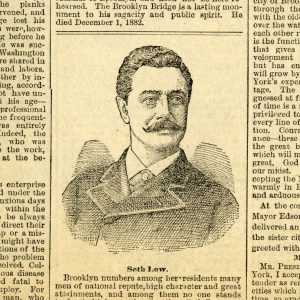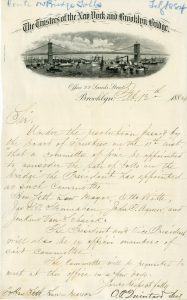The second season of Julian Fellow’s The Gilded Age on Max followed the lives of New Yorkers and Brooklynites in 1883. This season viewers learned about the fight to save the “colored schools” in New York, the opening of the Brooklyn Bridge, and even a visit to Booker T. Washington’s Tuskegee Institute. Connected to all these storylines is a real Columbian: Seth Low, Columbia College Class of 1870 alumnus (and later University President), who also was the Mayor of Brooklyn from 1881 to 1885.

This season, viewers met Sarah J. Garnet and her fight to save the colored schools in New York (now Manhattan). The character of Arthur Scott learns that the Board of Education has secretly changed their meeting time but he manages to get Garnet, her supporters and evidentiary documents in front of the Board just in time. Why were these Brooklyn parents involved in the campaign to save New York colored schools? Most likely the show writers were inspired by similar events in the life of Black pharmacist Philip A. White, the real life inspiration for the character of Arthur Scott. In Brooklyn, White was personally involved with the integration of public schools and the preservation of those colored schools.
Starting in 1881, the editor of the Globe T. Thomas Fortune (the real life person, not the character) made a number of calls in his paper for the Mayor to appoint a Black member to the Brooklyn Board of Education. A Black member would ensure equal funding for the Colored Schools (there were 4 in Brooklyn at the time) and would represent Black Brooklynites’ interests. The Mayor of Brooklyn was Columbia alumnus, board member and future University President (1890-1901) Seth Low. And Low listened to those calls. In 1882, he appointed Phillip A. White to the Board of Education. He was the first African American appointed to the Board, and the first in a major American city.
The real-life Philip A. White was in favor of school integration and had even tried (unsuccessfully) to enroll his own children in a Brooklyn district school in 1876. While some Black families wanted to enroll their children in their local district schools (rather than travel longer distances to colored schools), others wanted their children to be educated in schools staffed primarily by Black teachers and principals. In 1883, with White on the Board, the Brooklyn Board of Education passed a resolution that all district schools were required to admit any student living within their enrollment boundaries or districts. At the same time, a second resolution to close the colored schools failed to pass. White argued for the colored schools to remain in place as schools of choice for Black families.

Through the appointment of Phillip White, Mayor Seth Low is credited with integrating Brooklyn public schools. He also started a program to provide free textbooks to all public school students, not just those who had taken the “pauper’s oath.” Low was also a member of the board of the New York Bridge Company, the company that built the Brooklyn Bridge. As part of the bridge opening festivities in 1883, Mayor Seth Low walked the bridge to meet his New York counterpart Mayor Franklin Edson. Finally, from 1907 until his death in 1916, Seth Low served as the chair of the Board for Booker T. Washington’s Tuskegee Institute. Maybe in a future season of the show there will be an actor cast as Columbia’s own Seth Low.
For more information about the Brooklyn Colored Schools and Philip White:
- Hurst, Marsha. “Integration, Freedom of Choice, and Community Control in Nineteenth-Century Brooklyn,” Journal of Ethnic Studies 3, no. 3 (Fall 1975), 33–55.
- Kafka, Judith, and Matheny, Cici. “Racial Integration, White Appropriation, and School Choice: The Demise of the Colored Schools of Late Nineteenth Century Brooklyn.” Journal of Urban History 2022, Vol. 48 (1), 35–62.
- Peterson, Carla L. Black Gotham: a family history of African Americans in nineteenth-century New York City. New Haven: Yale University Press, 2011.